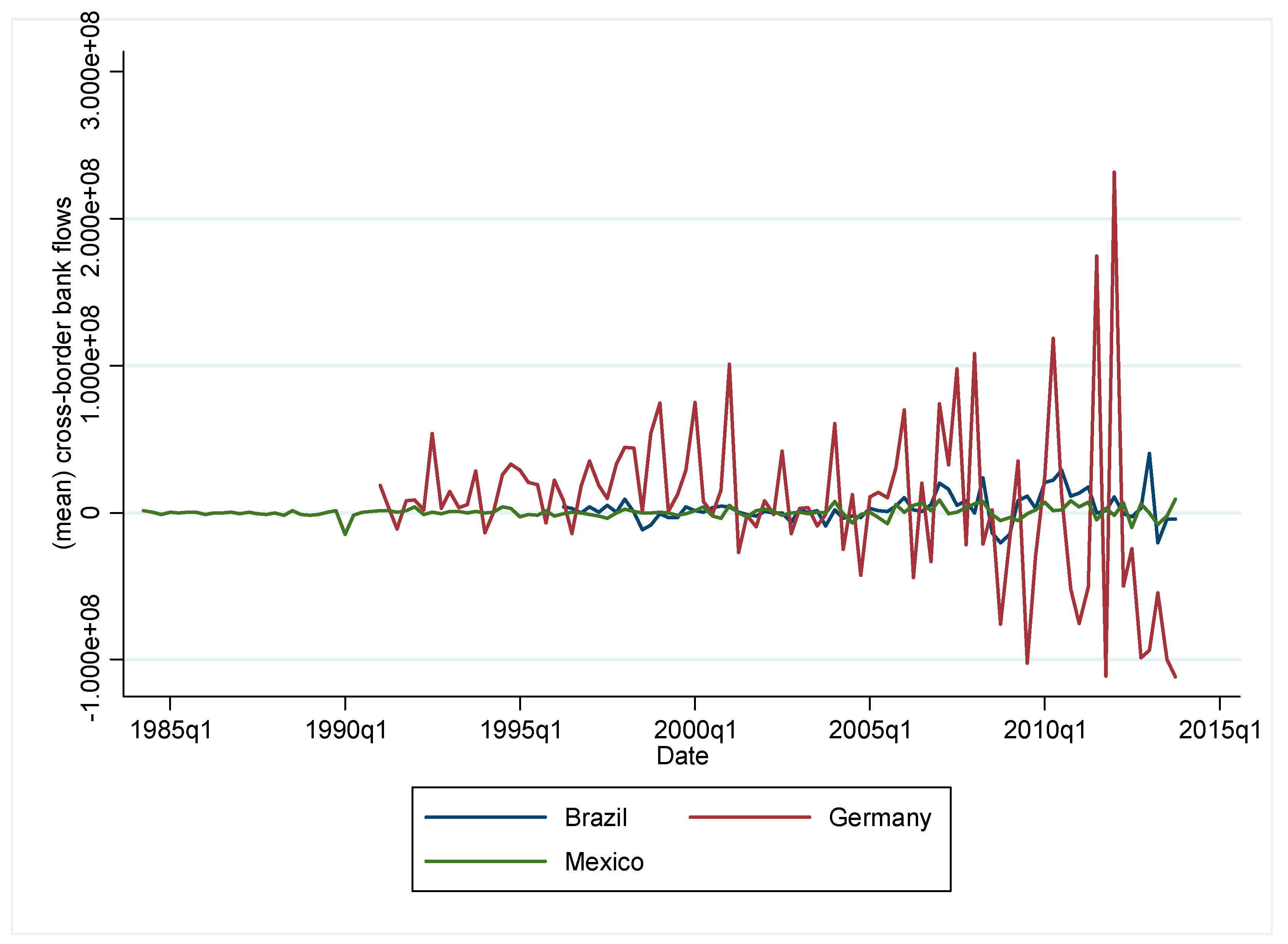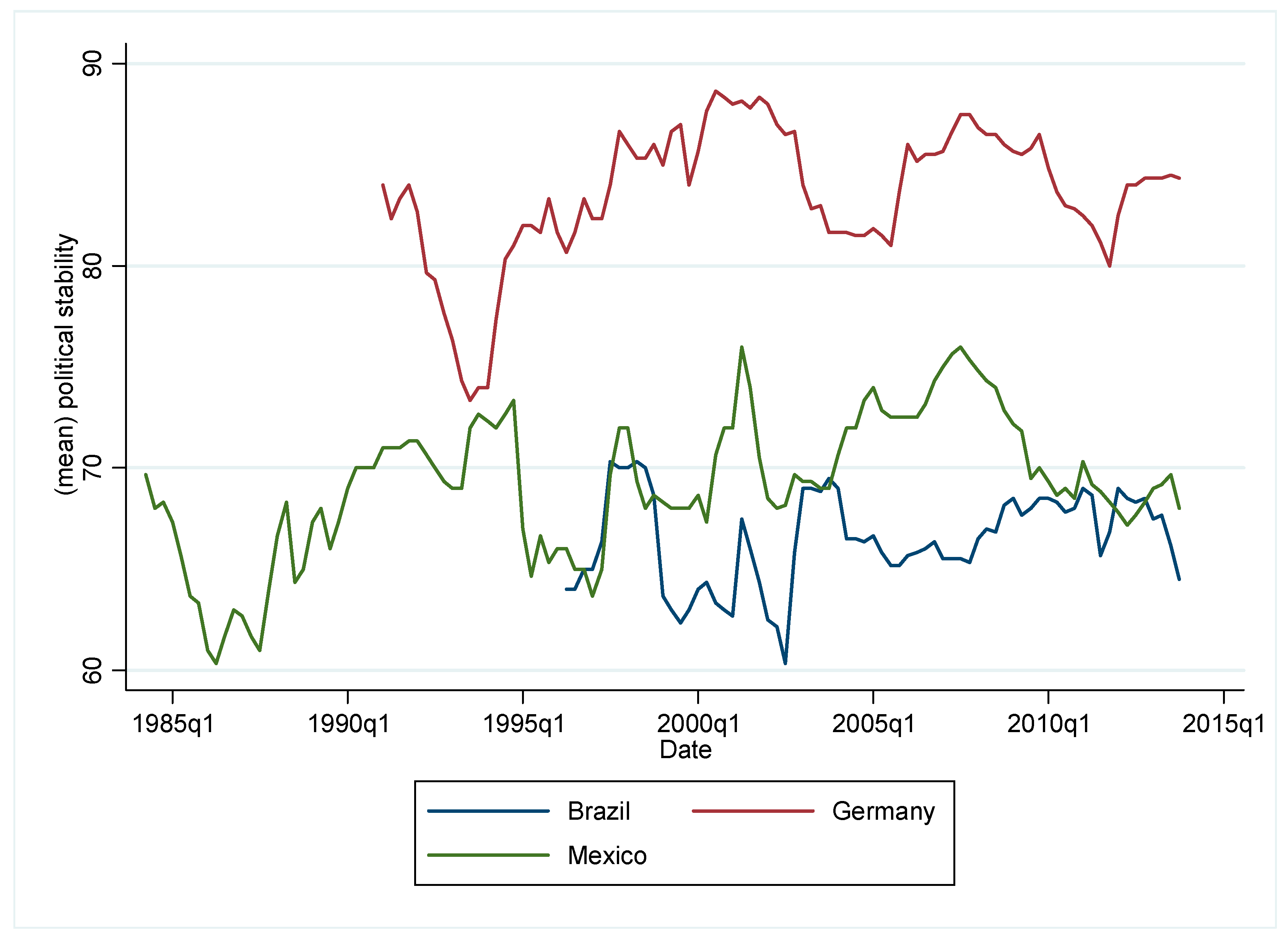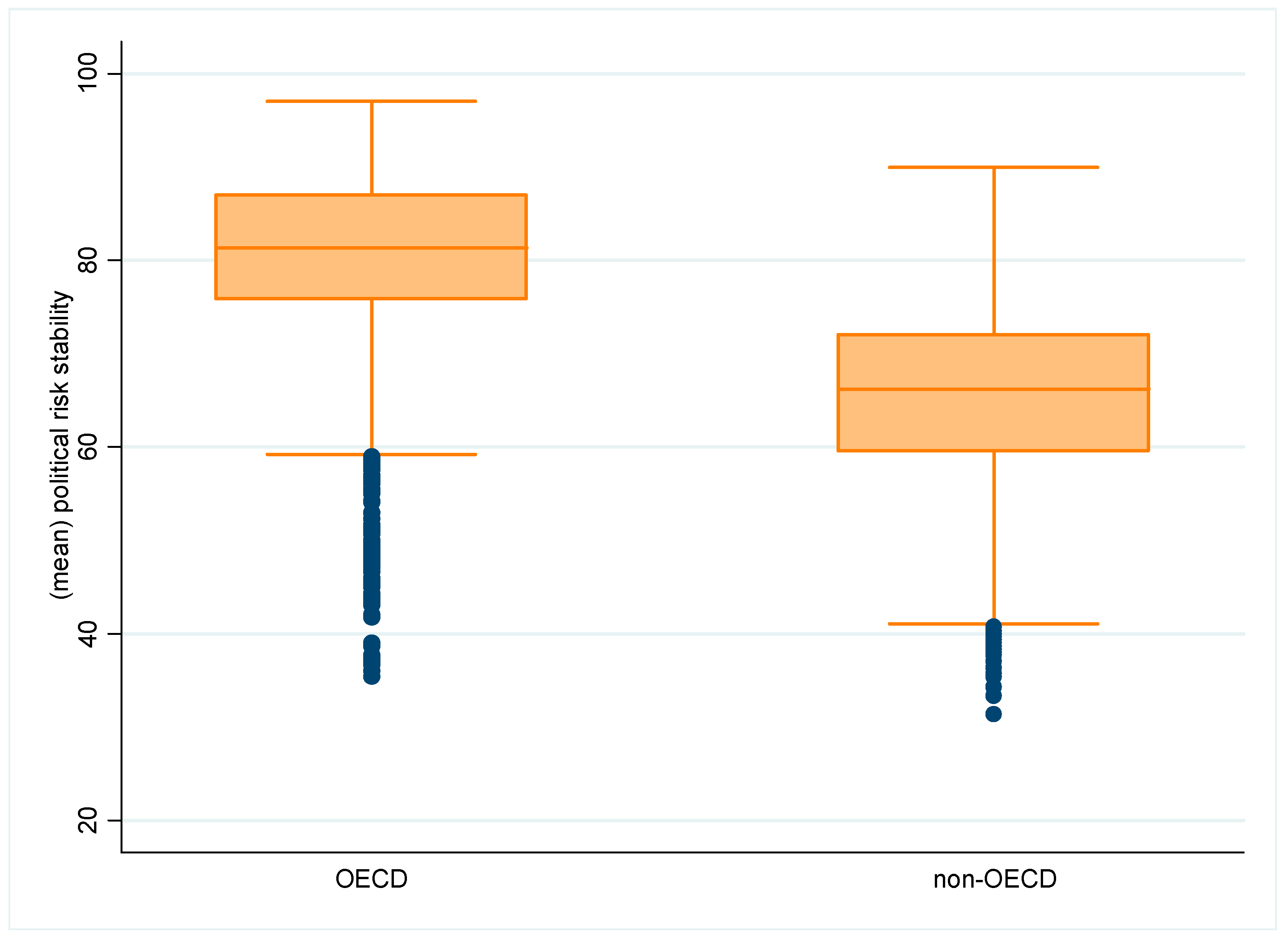Appendix A.2. Definition of the Political Stability Components
Government stability: According to the ICRG, this is an assessment both of the government’s ability to carry out its declared program(s), and its ability to stay in office. The risk rating assigned is the sum of three subcomponents, each with a maximum score of four points and a minimum score of 0 points. A score of 4 points equates to Very Low Risk and a score of 0 points to Very High Risk.
The subcomponents are:
Government Unity
Legislative Strength
Popular Support
Socioeconomic conditions: According to the ICRG, this is an assessment of the socioeconomic pressures at work in society that could constrain government action or fuel social dissatisfaction. The risk rating assigned is the sum of three subcomponents, each with a maximum score of four points and a minimum score of 0 points. A score of 4 points equates to Very Low Risk and a score of 0 points to Very High Risk.
The subcomponents are:
Unemployment
Consumer Confidence
Poverty
Investment profile: According to the ICRG, this is an assessment of factors affecting the risk to investment that are not covered by other political, economic and financial risk components. The risk rating assigned is the sum of three subcomponents, each with a maximum score of four points and a minimum score of 0 points. A score of 4 points equates to Very Low Risk and a score of 0 points to Very High Risk.
The subcomponents are:
Corruption: According to the ICRG methodology, corruption is an assessment of corruption within the political system. Such corruption is a threat to foreign investment for several reasons: it distorts the economic and financial environment; it reduces the efficiency of government and business by enabling people to assume positions of power through patronage rather than ability; and, last but not least, introduces an inherent instability into the political process. The most common form of corruption met directly by business is financial corruption in the form of demands for special payments and bribes connected with import and export licenses, exchange controls, tax assessments, police protection, or loans. Such corruption can make it difficult to conduct business effectively, an in some cases may force the withdrawal or withholding of an investment. Although our measure takes such corruption into account, it is more concerned with actual or potential corruption in the form of excessive patronage, nepotism, job reservations, “favor-favors”, secret party funding, and suspiciously close ties between politics and business. In our view these insidious sorts of corruption are potentially of much greater risk to foreign business in that they can lead to popular discontent, unrealistic and inefficient controls on the state economy, and encourage the development of the black market. The greatest risk in such corruption is that at some time it will become so overweening, or some major scandal will be suddenly revealed, as to provoke a popular backlash, resulting in a fall or overthrow of the government, a major reorganizing or restructuring of the country´s political institutions, or, at worst, a breakdown in law and order, rendering the country ungovernable.
Religious tensions: this variable measures tensions among religious groups. According to the ICRG definition, religious tensions may stem from the domination of society and/or governance by a single religious group that seeks to replace civil law by religious law and to exclude other religions from the political and/or social process; the desire of a single religious group to dominate governance; the suppression of religious freedom; the desire of a religious group to express its own identity; separate from the country as a whole. The risk involved in these situations range from inexperienced people imposing inappropriate policies through civil dissent to civil war.
Law and order: According to the ICRG, “Law and Order” form a single component, but its two elements are assessed separately, with each element being scored from zero to three points. To assess the “Law” element, the strength and impartiality of the legal system are considered, while the “Order” element is an assessment of popular observance of the law. Thus, a country can enjoy a high rating—3—in terms of its judicial system, but a low rating—1—if it suffers from a very high crime rate if the law is routinely ignored without effective sanction (for example, widespread illegal strikes).
Ethnic tensions: According to the ICRG, this component is an assessment of the degree of tension within a country attributable to racial, nationality, or language divisions. Lower ratings are given to countries where racial and nationality tensions are high because opposing groups are intolerant and unwilling to compromise. Higher ratings are given to countries where tensions are minimal, even though such differences may still exist.
Democratic Accountability: According to the ICRG, this is a measure of how responsive government is to its people, on the basis that the less responsive it is, the more likely it is that the government will fall, peacefully in a democratic society, but possibly violently in a non-democratic one.
The points in this component are awarded on the basis of the type of governance enjoyed by the country in question. For this purpose, the ICRG defines the following types of governance.
Appendix A.2.1. Alternating Democracy
The essential features of an alternating democracy are:
A government/executive that has not served more than two successive terms,
Free and fair elections for the legislature and executive as determined by constitution or statute,
The active presence of more than one political party and a viable opposition,
Evidence of checks and balances among the three elements of government: executive, legislative and judicial,
Evidence of an independent judiciary,
Evidence of the protection of personal liberties through constitutional or other legal guarantees.
Appendix A.2.2. Dominated Democracy
The essential features of a dominated democracy are:
Government/executive that has served more than two successive terms,
Free and fair elections for the legislature and executive as determined by constitution or statute,
The active presence of more than one political party,
Evidence of checks and balances between the executive, legislature, and judiciary,
Evidence of an independent judiciary,
Evidence of the protection of personal liberties.
Appendix A.2.3. De Facto One-Party State
The essential features of a de facto one-party state are:
A government/executive that has server more than two successive terms, or where the political/electoral system is designed or distorted to ensure the domination of governance by a particular government/executive,
Holding of regular elections as determined by constitution or statute,
Evidence of restrictions on the activity of non-government political parties (disproportionate media access between the governing and non-governing parties, harassment of the leaders and/or supporters of non-government political parties, the creation of impediments and obstacles affecting only the non-government political parties, electoral fraud, etc.).
Appendix A.2.4. De Jure One-Party State
The identifying feature of a one-party state is:
A constitutional requirement that there be only one governing party,
Lack of any legally recognized political opposition.
Appendix A.2.5. Autarchy
The identifying feature of an autarchy is: Leadership of the state by a group or single person, without being subject to any franchise, either through military might or inherited right. In an autarchy, the leadership might indulge in some quasi-democratic processes. In its most developed form this allows competing political parties and regular elections, through popular franchise, to an assembly with restricted legislative powers (approaching the category of a de jure or de facto one-party state). However, the defining feature is whether the leadership, i.e., the head of government, is subject to election in which political opponents are allowed to stand. In general, the highest number of risk points (lowest risk) is assigned to Alternating Democracies, while the lowest number of risk points (highest risk) is assigned to Autarchies.
Bureaucracy quality: According to the ICRG, the institutional strength and quality of the bureaucracy is another shock absorber that tends to minimize revisions of policy when governments change. Therefore, high points are given to countries where the bureaucracy has the strength and expertise to govern without drastic changes in policy or interruptions in government services. In these low-risk countries, the bureaucracy tends to be somewhat autonomous from political pressure and to have an established mechanism for recruitment and training. Countries that lack the cushioning effect of a strong bureaucracy receive low points because a change in government tends to be traumatic in terms of policy formulation and day-to-day administrative functions.







